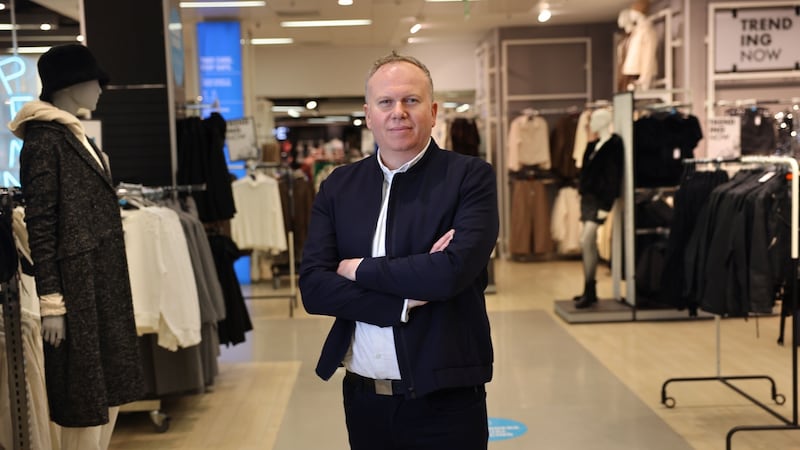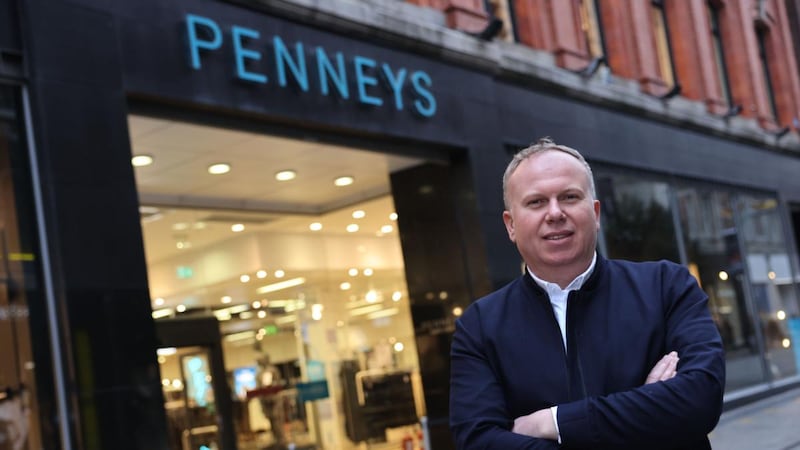When Arthur Ryan opened his first Penneys store on Mary Street on the northside of Dublin city centre more than 50 years ago, he was told he was setting up shop in the wrong location.
“When the buskers set up shop outside the store, he knew he’d made it,” says David Paterson, Primark’s chief financial officer as we walk up the stairs of Arthur Ryan House, the global hub for a fashion retail network that now spans 399 outlets in 14 countries, with 70,000 staff and €6.5 billion in annual sales.
The trendy and currently deserted head office is next door to its now 8,900 sq m (96,000 sq ft) Mary Street store, a flagship outlet that was the birthplace of the brand, opening in 1969 with Manchester United footballer George Best as the guest of honour.


In the middle of June last year, long lines of eager shoppers queued around the corner as the store opened following three months of harsh lockdown restrictions in the first wave of the Covid-19 pandemic. Unfortunately, it was shuttered again for the first half of this year.
According to Paterson it was Penneys busiest store pre-Covid handling “several thousands” of customers per day.
He neatly sidesteps the question of how many people typically pass through the store now, as we experience another Covid surge, but it is “building well” and the store manager is ”delighted” with how it’s going.
Just a handful of people were pottering around the shop when we met but it was 9.30am. “It’s always been a busy store for us and obviously it’s the original Penneys store,” he says. “What we’ve seen as we’ve emerged from closure is that some of these big city centre destination stores have recovered at a slower rate than some of the mostly local stores. That’s because we don’t have tourists and with the working from home you don’t have the commuters that you would normally have.”
On Friday, Penneys announced a €250 million investment in its Irish store network, which will add 20 per cent extra retail space and give it a store in the Square shopping centre in Tallaght for the first time, employing 300 staff. Some 700 new jobs will be created, including 100 roles at its head office.
“We think we have a fantastic opportunity in Ireland to grow our business,” he says. “The brand really resonates with customers, we saw that with the reopening so we want to continue to delight our customers but we need more selling space. We have a part to play in the rebuilding of the Irish economy as we emerge from the pandemic. And we see ourselves as a beacon on the high street. We’re not going to rest on our laurels. We’re not afraid to invest.”
Ryan, who died in 2019, would no doubt approve. Paterson, who hails from Surrey, just outside London, is part of the Primark leadership team that now carries the torch. “I was lucky enough to work with him for a few years before he passed. He was an absolute inspiration. Very sharp, very astute and at the same time incredibly funny, mostly at my expense it must be said.”
There was no mention in the announcement of a proposed replacement store in Dundrum Town Centre, where before the pandemic Penneys was understood to be on the cusp of signing up to take a large chunk of space previously occupied by House of Fraser. “We don’t typically talk about stores until they are signed, sealed and delivered,” he says.
On a quick walkabout of the Mary Street shop, Paterson highlights its extensive Christmas offering, the Late Late Toy Show products, an in-store nail and beauty bar, a Scrumdiddly’s ice cream parlour, some Disney branded clothes, a range of snuddies, which are trending at the minute, and a vast amount of pyjamas and socks. Paterson said it has sold “millions” of pyjamas here since the pandemic began in March 2020.
It’s all the more impressive when you consider that Penneys is a bricks and mortar retailer, eschewing online sales.
A quick mental calculation suggests that more than 700 pyjamas are packed into one of the stands he proudly shows me. As you might imagine, the prices are competitive. Everything from €1.30 for a two-pack of winter socks, to trainers from €12 and €50 for a warm winter coat. The snuddies start at €16.
“One of our strengths is our price leadership, that’s what our customers really are looking for,” Paterson says.
He also highlights its green credentials, with large recycling bins accepting unwanted clothes.
Store number 400 opens next week on the Italian island of Sicily, with ambitious plans in place to increase its footprint in the US to 60 shops from the current 13, and to get to 530 globally within five years.
To Primark, more and more bricks and mortar stores are its future. Every year it deploys €300 million-€400 million on capital investment.
It doesn’t sell its goods online, although it does use digital as a key marketing tool, with 24 million followers on social media. Paterson says a major investment in technology will allow it to showcase up to 70 per cent of its products online, compared with around 20 per cent at present.
Not even Covid lockdowns could persuade Primark to pivot to online sales. Why doesn’t it sell online?
“We’ve always said that one option that could be viable is click and collect but it’s got to be right thing for our business... and it’s got to make a sensible, adequate economic return as well. We’re always evaluating options for this business but it’s got to be at the right time and the right thing to do. At the moment, we are really excited about the opportunities for this business... opening new stores, increasing our selling space. We can see the customer demand for that experience.
“Our priority is around our digital assets, investing in those digital assets and driving footfall into the stores. We have a very successful business model and a very successful format and our customers like coming into our stores.”
Penneys is uniquely Irish, with the Primark brand deployed in other markets. Would it ever consider a switch in Ireland to the Primark name? “I’m not sure our customers would really appreciate that. We’d probably have a revolution on our hands. Penneys is an institution in Ireland and it resonates with our customers. We’re delighted with the brand and have no plans to change it.”
Brexit has been disruptive to its operation but it hasn't "materially impacted the business", he says. The new depot in Kildare, which will be heavily automated, will serve the whole island, a departure from previous practice.
A number of European retailers, including Tesco, have failed to conquer the US market but Paterson is confident that Primark will succeed, mostly because it is prepared to “listen and learn” and take a long-term view. “We learned around our store sizes, which was really interesting. We opened with above-average store sizes in a number of our US stores.
“We’d taken space from some of the department stores that were struggling so there were great deals to be done. But some customers told us that they found the stores overwhelming to shop. So we downsized three stores and that’s resulted in an enhanced customer experience, enhanced profitability because we’ve retained our sales and reduced the operating costs.”
During Covid, Primark broke out from its original US footprint in the northeast to open in Florida and downtown Chicago. “It’s been great to test the brand in different communities,” he says.
Primark is often referred to as a fast fashion brand – its low prices encouraging people to buy more clothes, which are quickly discarded and replaced with yet more cheap clothes that are typically shipped in from Asia.
Paterson rejects this characterisation, and highlights the Primark Cares sustainability strategy that has been developed for the next decade.
“At the heart of this is an ambitious strategy that looks at the life of our products, the durability, sourcing sustainable cotton, around 25 per cent of our clothing today is made from sustainable sources and we clearly want to increase that. Recycling is really important to us... we want garments made from recycled fabrics. We want to halve our carbon emissions,” he says.
About 80 per cent of its emissions are from its supply chain partners in countries such as China, Bangladesh, India and Turkey, where most of its products are manufactured. “We’re going to work with them on that ...to deliver more energy efficient factories. And we want to improve the lives of all those who work in our supply chain. This is about making sustainable fashion that is affordable for all.”
None of the clothes in the Mary Street store are made in Ireland, according to Paterson. And while it ships its goods from Asia to Europe, which is more climate friendly than transporting them by air, how is it good for the planet for multinational retailers such as Primark to ship goods across the world and to continue adding more and more shops to its global network?
“If we can create more durability for the products then we give customers more choice about what they buy and when they buy. It’s about achieving less waste. We’ve achieved that with our hangars by removing about 500 million single plastic use items in the last few years and have a target to reduce it by another 300 million. We think we can scale but scale in a responsible manner.”
He is wearing a white Penneys shirt that he expects to “last several years”.
“I’m still wearing Penneys stuff that I’ve had since I joined the company in 2017,” he says.
Ultimately, customers will have the final say on Primark’s climate change credentials. So far they seem content.
Paterson hails from Claygate, an affluent suburban village situated about 13 miles from London. He gained a BA in Leeds University and later participated in a corporate finance programme in London Business School while making a career in the travel sector.
Paterson moved to Dublin in January 2012 with his Irish wife and two young boys to take a job with Car Trawler, the Irish travel technology company, after a couple of years with Spanish group Hotelbeds.
He left the travel sector behind, joining Penneys in March 2017. “Penneys came along as an opportunity and I was attracted to the fact that actually you couldn’t find out much about the business but I knew it was very successfully. I was attracted by the strength of the brand, the consumer appeal, the international opportunity, and it felt like we’re still quite early in our journey as a business. It’s exciting to be part of a growth story...and a true Irish success story.”
***********
CV
Name: David Paterson
Job: Chief financial officer Primark
Age: 48
Family: Married to Leonie with two children
Lives: Rathmines
Hobbies: Golf, drinking red wine, and sport.
Something we might expect: He wears some Penneys clothing every day. "You've got to live the brand."
Something that might surprise: "I relax by listening to house music and I used to be a bit of a bedroom amateur DJ in my time. I took up running during Covid and that's when I listen to my house music."









